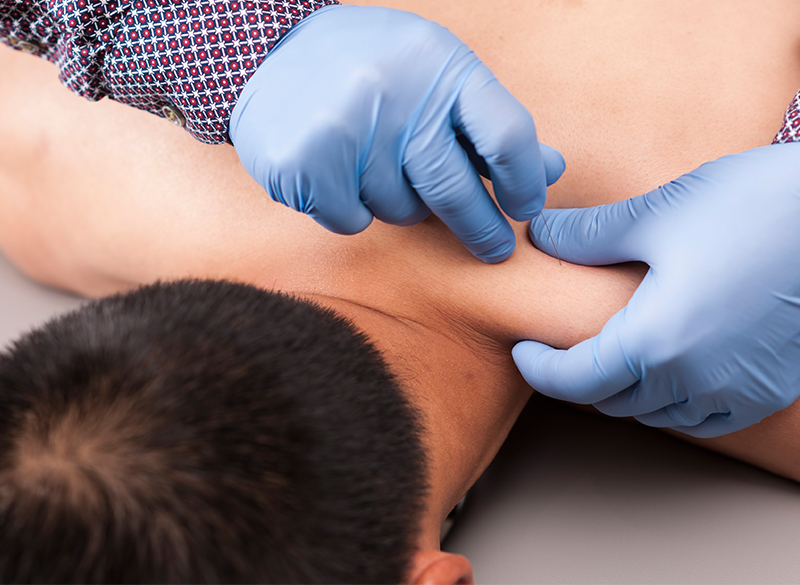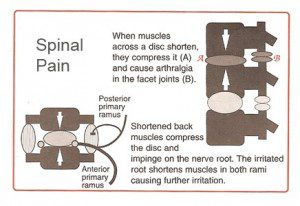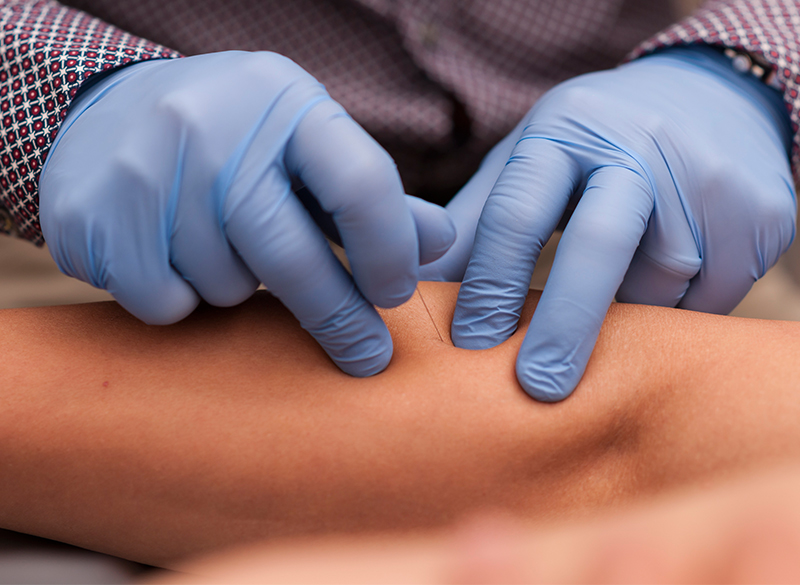
Available at St. Albert, Royal Glenora, Windermere, Capilano Rehabilitation Centre, Old Strathcona, Sherwood Park, Spruce Grove, Leduc, Heritage Valley, University District Calgary, Tower Sports Medicine Calgary, Okotoks, and Glenmore Landing Calgary locations.
IMS can release stubborn tight muscles and may solve your chronic pain
Leading Edge Physiotherapy is pleased to offer IMS – Intra-Muscular Stimulation in Edmonton, Calgary, Sherwood Park, Spruce Grove and St. Albert, Alberta.
Do you have a chronic pain or injury? Despite treatment, have the aches and pains just not gone away? Don’t give up! If you have been suffering aches, pains or numbness in your back, neck, arms, shoulders or legs, IMS may be for you.
Although IMS uses implements adapted from traditional acupuncture, it is based on scientific western medical neurophysiological principles. The acupuncture needle used is very thin. Patients are unlikely to feel it penetrate the skin, and if the muscle is normal, the needle is painless. However, if the muscle is supersensitive, shortened or dysfunctional, a peculiar sensation ensues – like a muscle cramp, dull ache or Charlie Horse. The result is a release of tense shortened muscles and desensitization of pain that arises from “neuropathy.”
IMS Treats Chronic Pain and Myofascial Pain of Neuropathic Origin: chronic back & neck pain be gone!
Doctors and other professionals are frequently perplexed by pain that shows no sign of tissue damage or inflammation – chronic headaches, whiplash, backache, neck tension, tennis elbow, frozen shoulder, rotator cuff tendinitis or even recurrent pulled hamstrings. This is a difficult area of medicine, since medical tests often prove inconclusive and its underlying cause is not broadly understood.
This type of chronic pain, known as neuropathic pain, typically occurs when nerves malfunction following minor irritation or injury. The term Neuropathy literally means “nerve that is unwell.” When this occurs, the nerves and nerve-endings become extremely sensitive and cause innocent, harmless signals to be exaggerated and misperceived as painful ones. (This characteristic is known medically as supersensitivity). The result is pain, even when extensive medical tests show there is “nothing wrong.” These sensitive nerves cause, among other things, contraction of muscles or muscle shortening.
The tightness in the skeletal muscle system and its connective tissue, as well as the pain arising from this tightness, is called myofascial pain.
patients with this kind of pain commonly complain of:
- Loss of range of motion
- Tightness in their muscles
- Tenderness to touch in the muscles (muscle knots and trigger points)
Pain may occur immediately following injury and persist for months to years, or it may have a delayed onset, such as after a motor vehicle collision when the pain seems to appear days to weeks after the incident.
Unfortunately, supersensitivity and muscle shortening cannot be operated on and “cut away”. Painkillers and other analgesic pills only mask the pain, solving the brain’s perception of the pain but not the source. The goal of IMS treatment is to release muscle shortening, desensitize the nerve and create a new healing process. With Gunn IMS, supersensitive areas can be desensitized and the persistent pull of shortened muscles released. This is the “awwww, feels good” part!
Even when massage, joint adjustments (manipulation), active release, and other physical therapies have failed, this little needle and our skill can get to the source.
what causes this type of pain?
In short… life! The most common cause of nerve irritation and neuropathic pain is “spondylosis” or degeneration in the spine, which can be the result of normal wear and tear and affects us all universally.
Ultimately, this wear and tear causes the very irritation that leads to neuropathy – supersensitivity – muscle shortening and finally myofascial pain. Since spondylosis is nearly universal, we are all susceptible to developing this type of chronic pain. It is likely the reason that this type of pain is so prevalent and continues to be a silent epidemic.
Learn more about IMS in Edmonton and Calgary…
An important factor in neuropathic pain is muscle shortening, caused by muscle spasm and contracture. Muscle shortening produces pain by pulling on tendons, straining them and distressing the joints they move. These muscles also hurt because they compress and stress pain nerve endings within the muscles and joints themselves. Patients may feel that that their muscles are “tight all of the time,” that they have “always been tight,” or they “cannot be stretched out, no matter what.” Such complaints are all too common preceding the onset of chronic pain.
 Muscle shortening also increases wear and tear and contributes to degenerative changes such as “tendonitis,” “bursitis” and “osteoarthritis”. Often these are regarded as isolated, local conditions and may not receive the appropriate diagnosis or treatment until the pain becomes frustrating. The tennis elbow that never goes away… the ITband syndrome that can’t be stretched out… pain that isn’t aided by anti-inflammatories or muscle relaxants…sounding familiar?
Muscle shortening also increases wear and tear and contributes to degenerative changes such as “tendonitis,” “bursitis” and “osteoarthritis”. Often these are regarded as isolated, local conditions and may not receive the appropriate diagnosis or treatment until the pain becomes frustrating. The tennis elbow that never goes away… the ITband syndrome that can’t be stretched out… pain that isn’t aided by anti-inflammatories or muscle relaxants…sounding familiar?
The effects of IMS are cumulative – needling stimulates a certain amount of healing each treatment, until eventually the condition is healed and the pain disappears. According to Dr. Gunn’s research, some patients treated with IMS have remained painfree for over 20 years.
The IMS needle has a direct effect on the nerve route
This occurs through the stimulation of something known as the “stretch reflex.” When the needle enters shortened, supersensitive, neuropathic muscle it causes the muscle fibres to wrap around the needle and therefore pull on receptors at the end of the muscles called “muscle spindles.” This pulling causes a reflex contraction, and in doing so, stimulates the spinal nerve which in turn helps to desensitize the nerve. It further causes reflex relaxation in the muscle which helps to alleviate stress on the joints, tendons and pain nerve endings in the muscles themselves. Finally, the needle causes some bruising in the tissues which creates a new healing environment through the release of a chemical in the blood called “platelet derived growth factor.” These three effects of treatment allow our therapists to manage what other treatments have failed to resolve.
- Whiplash
- Headaches
- Neck pain
- Torticollis
- TMJ
- Upper back pain
- Frozen shoulder
- Rotator cuff syndrome
- Tendonitis and bursitis
- Spondylosis and degenerative disc disease
- Lower back pain
- Sciatica
- Tennis elbow
- Achilles tendinitis
- Carpal tunnel syndrome
- Piriformis syndrome
- Ischial bursitis
- Chronic sprains and strains
Treatments typically occur once a week to allow time between treatments for the body to heal itself. The number of treatments you require will depend on several factors such as the duration and extent of your condition, how much scar tissue there is (usually increased after previous surgery) and how quickly your body can heal. The rate of healing depends on the condition of your nerves (young people usually heal more quickly, although older is not necessarily slower). If the pain is of more recent origin, one treatment may be all that is necessary. In published studies of patients with low back pain, the average number of IMS treatments required was 8.2.
Intramuscular Stimulation (IMS) was developed by Dr. Chan Gunn while he was a clinic physician at the Workers’ Compensation Board of British Columbia. Dr Gunn, recently elected an Honorary Fellow of Peterhouse, Cambridge University, is currently a clinical professor and teaches IMS at the University of Washington’s Multidisciplinary Pain Centre in Seattle and the University of British Columbia’s Medical School.
Our senior physical therapists have trained directly with Dr. Gunn and all of our IMS therapists have studied and garnered certification from Dr. Gunn’s Institute for the Study and Treatment of Pain (ISTOP).
Because of Dr. Gunn’s research and this techniques results, family doctors and pain specialists are now garnering a better understanding of this area of pain. IMS is gathering strong support in the medical community as an effective management tool for pain that is all too often dismissed or ignored.
If you answer YES to any of the following 6 questions, you may be a candidate for IMS:
- Do you have pain that is a constant aching or burning type of pain?
- Do your muscles and joints feel stiff or tight?
- Do you have tender points in your muscles?
- Have you lost the range of motion in your affected body site?
- Do your limbs or extremities feel cold frequently?
- Are you suffering from or have been diagnosed with any of the problems described above?
Ultimately only after an assessment by a qualified professional can it be determined if IMS is the right treatment for your condition.
At Leading Edge Physiotherapy in Edmonton, Calagary and St. Albert, all of our IMS practitioners have undergone extensive post-graduate training from Grant Fedoruk and/or his team who have studied at Dr. Gunn’s Institute. Since IMS at our facility is performed by registered physical therapists, treatments are eligible for reimbursement by 3rd party insurance with physiotherapy benefits.






